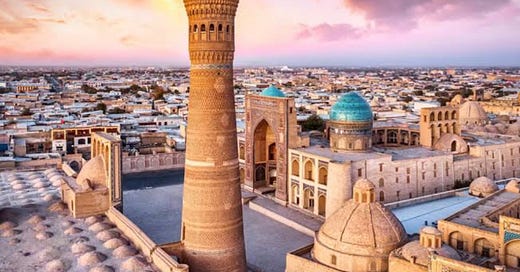I recently visited Bukhara in February and was captivated by its beauty. The city was adorned with fresh snow, creating a serene and enchanting atmosphere. Within the heart of the old town stands the magnificent Kalon Minaret. Its imposing presence against the pale winter sky serves as a poignant reminder of Bukhara’s rich historical heritage and the countless events that have transpired there.
Built way back in 1127 by Muhammad Arslan Khan, the minaret was originally used to call people to prayer from the nearby Kalon Mosque. Five times a day, the muezzin would climb these narrow stairs to the top and let his voice echo through the city. The minaret’s height helped the sound travel far, and it even served as a kind of lighthouse. Imagine being able to spot it from far away and use it to find your way to Bukhara!
But sadly, the minaret also has a dark side. In the past, prisoners were thrown from the top as a form of execution. It’s a heavy thought to imagine standing at the edge and feeling the weight of those stories.
The Minaret is part of a larger complex called the Poi Kalon, which includes the Kalon Mosque and the Mir-i-Arab Madrasa. This group of buildings is one of the most beautiful squares I’ve ever seen. The mosque’s large courtyard and arched galleries looked especially peaceful under the snow. The madrasa, with its turquoise domes and patterned tilework, stood proudly across from it. Even in winter, the area felt alive. Locals passed by, wrapped in long coats, while tourists stood in quiet admiration. It was a truly timeless experience.
Bukhara has been a major city on the Silk Road for centuries. It was a hub for trade, learning, and religion, home to famous scholars, poets, and philosophers. With its madrasas, libraries, and bustling bazaars, Bukhara attracted people from all over Central Asia, Persia, and beyond. It was a city of great wealth and influence—one of the jewels of the Islamic world.
Have you ever wondered why Genghis Khan visited Bukhara in 1220? It might have been because his armies were marching through Central Asia, and Bukhara stood in their way. Some say he wanted to crush the region’s resistance, while others believe he was drawn to its riches and fame.
Legend has it that when he entered the city, he climbed the Kalyan Minaret—or at least looked up at it—and was so impressed by its beauty that he spared it while most of the city was destroyed.
Climbing the steep, winding staircase of the minaret is no longer an option, but from the top, the view must be breathtaking. Imagine the rooftops of Bukhara stretching out below, white and silent. It’s easy to imagine the call to prayer echoing across the domes, the hum of a medieval marketplace, and even the stillness of that fateful moment when a conqueror paused before destroying something truly magnificent.
Visiting the Kaloan Minaret in person imbues its historical significance with a tangible and immediate presence. Amidst the snow-covered landscape and the surrounding silence, I gained a deeper appreciation for the enduring fascination it has exerted on travellers, rulers, and historians throughout history. The Kalyan Minaret stands as a prominent and recognisable landmark in Central Asia, embodying the resilience and enduring connection to Bukhara’s past.




Nicely penned, Shantanu!